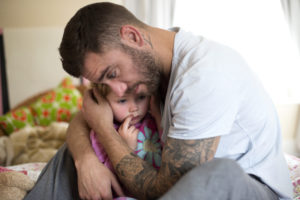Stress and anxiety: navigating a pandemic
 A virus like COVID-19 can create a lot of anxiety. And it can be difficult for students/children to understand – especially if someone in their school or family is sick and they’re exposed to hearing troubling messages on the radio, online or on television. Additionally, changes to learning patterns can add to the stress that students or families may be feeling right now.
A virus like COVID-19 can create a lot of anxiety. And it can be difficult for students/children to understand – especially if someone in their school or family is sick and they’re exposed to hearing troubling messages on the radio, online or on television. Additionally, changes to learning patterns can add to the stress that students or families may be feeling right now.
It’s important to remember that it’s totally normal for anybody to feel this way. And those feelings could manifest in a number of behaviours or across a range of emotions: anger, sadness, emotional distancing, regression into earlier developmental stages (things like bedwetting for younger kids), irritability, new struggles or outbursts at points of transition, to name a few things you might notice or feel happening.
Strategies and tips
Here’s what you can do to help worried kids, and yourself, through this situation:
- Reassure your students/children about their safety and health. Use the opportunity to remind and empower them with things they can do: practice good respiratory etiquette and hand hygiene, and talk to them about the preventative importance of social or physical distancing.
- Check yourself. Situations like this can be challenging for everyone, regardless of age or experience. Consider what children may or may not be picking up from you. And look after yourself as well, seeking support where you need it.
- Listen to students/children. Encourage them to share their feelings and ask questions … and provide them with age-appropriate information in return. (Resources below.)
- Do your best to answer their questions honestly, loop back to them if you need to first find the answer. And make sure you’re finding your information from trusted sources too … take a minute to question what you see on social media before sharing it.
- For younger children: More time with the adults they trust can help provide reassurance. Try your hand at baking, engage them to help you make meals, tackle an art project or play a board game together. Spend quiet time reading or get outside to play.
- For older children: it might be helpful to control the sheer amount of content they’re exposed to or the way they’re taking it in. Consider how much they see on social media, and be mindful of what they are exposed to in your shared viewing time and what they can overhear between conversations and news that’s on in the house. Conversely, consider whether viewing news together can open opportunities to engage with them and to create space for them to ask the questions they may already have.
- Maintaining familiar activities and routines as much as possible can help reinforce a sense of security for kids. Where social or physical distancing and has changed old that, consider creating new routines that can be practiced each day (adding in set patterns or times of day for walks, for their remote learning lessons, guided yoga or breathing via YouTube or other applications, reading times, free play time, etc).
- Focus on the positive. Talk about gratitude, find reasons to celebrate and use this time (when you can) to be a bit extra engaged as you spend together as a family.
- Stay healthy and active. Do what you can to look after your physical health: go for walks in less populated spaces, eat good food and make sure everybody is getting enough sleep.
- Point to the leaders and helpers. Talk to kids about the fact there are experts and leaders at every level working hard to keep people as safe as possible … in addition to you.
- And remind them that this is temporary.
Additional resources and tools
Looking for a tool to help talk to your kids about what’s happening? CBC Kids News and the BC Provincial Health Officer made this video: https://www.cbc.ca/kidsnews/post/watch-coronavirus-facts-versus-fiction
Is your child a tween? Here’s an article that outlines some of what you might want to say and what you might want to skim over more lightly:
https://www.nytimes.com/2020/03/02/well/family/coronavirus-teenagers-anxiety.html?ck_subscriber_id=660953421
For the most factual content on the science of COVID-19 and what’s happening in BC, try the BC Centre for Disease Control: http://covid-19.bccdc.ca/
If you or your family are feeling anxiety around COVID-19, the Canadian Mental Health Association has this great guide to managing anxiety: https://cmha.bc.ca/news/managing-anxiety-covid-19/
For a deeper dive into the psychology and tips on how to talk to kids about COVID-19, here’s a tool out of the US that’s great: https://www.nasponline.org/resources-and-publications/resources-and-podcasts/school-climate-safety-and-crisis/health-crisis-resources/talking-to-children-about-covid-19-(coronavirus)-a-parent-resource?ck_subscriber_id=660953421
*Translations and downloads available at the above link
Traducciones y descargas disponibles aquí en español
ትርጉሞች እና ማውረዶች በአማርኛ ይገኛሉ
提供中文翻译和下载
한국어로 제공되는 번역 및 다운로드
Traductions et téléchargements disponibles en français
Bản dịch và tải về có sẵn bằng tiếng Việt
Fraser Health has also created posters on how to speak to kids about COVID-19. They are available in:
English – 7 tips for talking to kids COVID
Hindi – 7 Tips for talking to kids COVID
Punjabi – 7 Tips for talking to kids COVID
Chinese – 7 tips for talking to kids COVID
Korean – 7 Tips talking to kids COVID
Persian – 7 Tips for talking to kids COVID
If your child needs somebody to talk to
- Reach out to your school counsellor, through your local school
- or try the Kids Help Phone: 1-800-668-6868.
